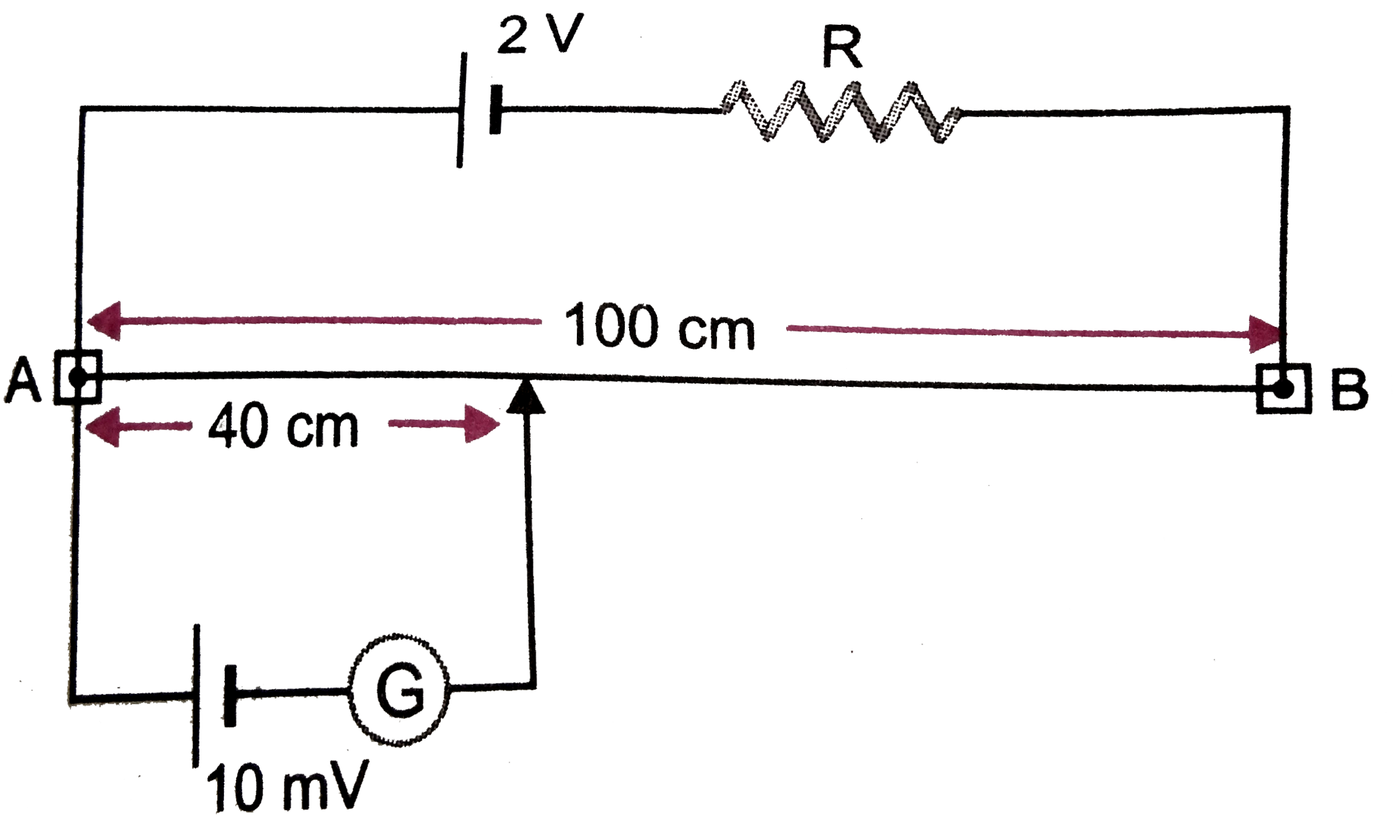Two tangent galvanometers A and B have coils of radii 8cm and 16cm respectively and resistance 8ohm each. They are connected in parallel to a cell of emf 4V and negligible internal resistance. The deflections produced are 30∘ and 60∘ respectivley. A has 2 turns. What is the number of turns in B?
18 turns
12 turns
6 turns
2 turns
The correct Answer is:B
To solve the problem, we need to find the number of turns in galvanometer B, given the parameters of both galvanometers A and B.
1. Identify the Given Data:
- Radius of galvanometer A, RA=8cm=0.08m
- Radius of galvanometer B, RB=16cm=0.16m
- Resistance of both galvanometers, RA=RB=8Ω
- EMF of the cell, V=4V
- Deflection angle for A, θA=30∘
- Deflection angle for B, θB=60∘
- Number of turns in A, nA=2
2. Calculate the Equivalent Resistance:
Since the galvanometers are connected in parallel, the equivalent resistance Req can be calculated using the formula:
Req=RA⋅RBRA+RB=8⋅88+8=6416=4Ω
3. Calculate the Total Current through the Circuit:
Using Ohm's law, the total current I flowing through the circuit can be calculated as:
I=VReq=4V4Ω=1A
4. Use the Tangent Law for Galvanometers:
The current through each galvanometer is proportional to the tangent of the deflection angle and the number of turns:
IA=kAtan(θA)andIB=kBtan(θB)
where k is a constant that depends on the radius and number of turns.
5. Express the Constants kA and kB:
The constant k can be expressed as:
k=2πRnμ0
Therefore, for galvanometer A:
kA=2πRAnAμ0=2π(0.08)(2)μ0
For galvanometer B:
kB=2πRBnBμ0=2π(0.16)nBμ0
6. Set Up the Proportionality:
Since the current is the same for both galvanometers:
IA=IB
This gives us:
kAtan(30∘)=kBtan(60∘)
7. Substituting the Values:
Substitute kA and kB:
2π(0.08)(2)μ0⋅tan(30∘)=2π(0.16)nBμ0⋅tan(60∘)
The 2π and μ0 cancel out:
(0.08)(2)tan(30∘)=(0.16)nBtan(60∘)
8. Substituting the Tangent Values:
We know:
tan(30∘)=1√3andtan(60∘)=√3
Substitute these values:
(0.08)(2)⋅1√3=(0.16)nB⋅√3
9. Solving for nB:
Rearranging gives:
nB=(0.08)(2)(0.16)(√3)⋅11√3
Simplifying:
nB=0.160.16⋅3=3
10. Final Calculation:
Therefore, the number of turns in galvanometer B is:
nB=12
Conclusion:
The number of turns in galvanometer B is 12 turns.
- Radius of galvanometer A, RA=8cm=0.08m
- Radius of galvanometer B, RB=16cm=0.16m
- Resistance of both galvanometers, RA=RB=8Ω
- EMF of the cell, V=4V
- Deflection angle for A, θA=30∘
- Deflection angle for B, θB=60∘
- Number of turns in A, nA=2
Since the galvanometers are connected in parallel, the equivalent resistance Req can be calculated using the formula:
Req=RA⋅RBRA+RB=8⋅88+8=6416=4Ω
Using Ohm's law, the total current I flowing through the circuit can be calculated as:
I=VReq=4V4Ω=1A
The current through each galvanometer is proportional to the tangent of the deflection angle and the number of turns:
IA=kAtan(θA)andIB=kBtan(θB)
where k is a constant that depends on the radius and number of turns.
The constant k can be expressed as:
k=2πRnμ0
Therefore, for galvanometer A:
kA=2πRAnAμ0=2π(0.08)(2)μ0
For galvanometer B:
kB=2πRBnBμ0=2π(0.16)nBμ0
Since the current is the same for both galvanometers:
IA=IB
This gives us:
kAtan(30∘)=kBtan(60∘)
Substitute kA and kB:
2π(0.08)(2)μ0⋅tan(30∘)=2π(0.16)nBμ0⋅tan(60∘)
The 2π and μ0 cancel out:
(0.08)(2)tan(30∘)=(0.16)nBtan(60∘)
We know:
tan(30∘)=1√3andtan(60∘)=√3
Substitute these values:
(0.08)(2)⋅1√3=(0.16)nB⋅√3
Rearranging gives:
nB=(0.08)(2)(0.16)(√3)⋅11√3
Simplifying:
nB=0.160.16⋅3=3
Therefore, the number of turns in galvanometer B is:
nB=12
The number of turns in galvanometer B is 12 turns.
Similar Questions
Two resistors of 2.0 92 and 3.0 22 are connected
in parallel, with a battery of 60 V and negligible internal resistance. For each case draw a circuit diagram and calculate the current through the batteryView SolutionTwo cells of emfs 1.5 V and 2.0v having internal resistance 0.2Σ and 0.3 Σ respectively are connected in parallel . Calculate the emf and internal resistance of the equivalent cell .
View Solution
Knowledge Check
- Question 1 - Select One
A potentiometer wire of length 100cm has a resistance of 10Ω. It is connected in series with a resistance and a cell of emf 2V and of negligible interal resistance. A source of emf 10mV is balanced against a length of 40cm of the potentiometer wire. What is the value of external resistance?
A790ΩB890ΩC990ΩD1090Ω
Two parallel wires PQ, RS of resistance 10Ω and 20Ω are seperated by a distance of 10 cm and connected in parallel across a cell of emf200V and negligible intemal resistance. A wire AB of mass I g and length 1 cm is balanced exactly, between them. What must be the current in it.
View SolutionTwo resistance connected in parallel across a cell of negligible internal resistance, use 4.5 times the power that they would use, when in series across the same cell. If one of the resistance is 8ohm, the other is:-
View SolutionTwo tangent galvanometers having coils of the same radius are connected in series. A current flowing in them produces deflections of 60∘ and 45∘ respectively. The ratio of the number of turns in the coils is
View SolutionTwo tangent galvanometers having coils of the same radius are connected in series. A current flowing in them produces deflections of 60∘ and 45∘ respectively. The ratio of the number of turns in the coils is
View SolutionA coil of 50 turns and 20cm diameter is made with a wire of 0.2mm diameter and resistivity 2×10−6Ωcm.The coil is connected to a source of EMF20V and negligible internal resistance.
Find the current through the coil.View SolutionA potentiometer wire of length 100cm having a resistance of 10Ω is connected in series with a resistance R and a cell of emf 2V of negligible internal resistance. A source of emf

of 10mV is balanced against a length of 40cm of the potentiometer wire. What is the value of resistance R ?View SolutionA potentiometer wire of length 100cm having a resistance of 10Ω is connected in series with a resistance R and a cell of emf 2V of negligible internal resistance. A source of emf

of 10mV is balanced against a length of 40cm of the potentiometer wire. What is the value of resistance R ?View Solution

